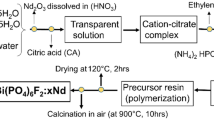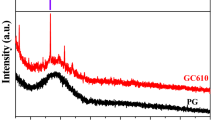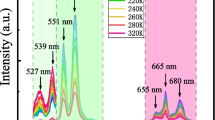Abstract
Fluorescent materials doped with rare-earth ions have raised great interest because of their prominent use in near-infrared temperature sensing, where their application in biological systems is possible. In this work, the performance of Nd3+-doped calcium yttrium silicate (CYS) ceramic powder phosphor prepared by combustion synthesis method for optical temperature sensing is discussed. The material is amorphous after heat-treatment at 700 °C, and it exhibits intense near-infrared (NIR) fluorescence when the sample is irradiated by a CW laser radiation at λ ~ 532 nm. The characteristic emission peaks of Nd3+ in the NIR region, centered at 811 and 895 nm, were observed corresponding to the 4F5/2 and 4F3/2 multiplets relaxation to the ground state. By inspecting the fluorescence behavior of these NIR emissions as a function of temperature, a noticeable change on the relative intensities corresponding to transitions 4F5/2 → 4I9/2 and 4F3/2 → 4I9/2 in the temperature range of 298–673 K was observed. Through the use of the fluorescence intensity ratio technique, the optical temperature sensing performance was studied assuming a quasi-equilibrium Boltzmann population distribution among the thermally coupled levels 4F5/2 and 4F3/2. A maximum absolute sensitivity Sa of ~ 3.2 × 10−3 K−1 at 795 K and a relative thermal sensitivity Sr of 1.59% K−1 at 298 K were obtained. These results indicate that the Nd3+-doped CYS powder system studied here exhibits a potential use in thermal sensing within the first biological window (700–950 nm).
Graphical abstract





source: CW laser (532 nm, 100 mW)

Similar content being viewed by others
References
D. Jaque, F. Vetrone, Luminescence nanothermometry. Nanoscale 4, 4301–4326 (2012)
C.D.S. Brites, P.P. Lima, N.J.O. Silva, A. Millán, V.S. Amaral, F. Palacio, L.D. Carlos, Thermometry at the nanoscale. Nanoscale 4, 4799–4829 (2012)
X.D. Wang, O.S. Wolfbeis, R.J. Meier, Luminescent probes and sensors for temperature. Chem. Soc. Rev. 42, 7834–7869 (2013)
E. Hemmer, P. Acosta-Mora, J. Mendez-Ramos, S. Fischer, Optical nanoprobes for biomedical applications: shining a light on upconverting and near-infrared emitting nanoparticles for imaging, thermal sensing, and photodynamic therapy. J. Mater. Chem. B 5, 4365–4392 (2017)
B. Liu, C.X. Li, P.P. Yang, Z.Y. Hou, J. Lin, 808-nm-Light-excited lanthanide-doped nanoparticles: rational design, luminescence control and theranostic applications. Adv. Mater. 29, 1605434 (2017)
L. Marciniak, A. Bednarkiewicz, D. Kowalska, W. Strek, A new generation of highly sensitive luminescent thermometers operating in the optical window of biological tissues. J. Mater. Chem. C 4, 5559–5563 (2016)
L. Marciniak, A. Bednarkiewicz, W. Strek, Tuning of the up-conversion emission and sensitivity of luminescent thermometer in LiLaP4O12:Tm, Yb nanocrystals via Eu3+ dopants. J. Lumin. 184, 179–184 (2017)
S.S. Zhou, S. Jiang, X.T. Wei, Y.H. Chen, C.K. Duan, M. Yin, Optical thermometry based on upconversion luminescence in Yb3+/Ho3+ co-doped NaLuF4. J. Alloys Compd. 588, 654–657 (2014)
J.S. Zhong, D.Q. Chen, Y.Z. Peng, Y.D. Lu, X. Chen, X.Y. Li, Z.G. Ji, A review on nanostructured glass ceramics for promising application in optical thermometry. J. Alloys Compd. 763, 34–48 (2018)
Li. Che, B. Dong, Ch. Ming, M. Lei, Application to temperature sensor based on green up-conversion of Er3+ doped silicate glass. Sensors 7, 2652–2659 (2007)
E. Maurice, G. Monnom, B. Dussardier, A. Saïssy, D.B. Ostrowsky, G.W. Baxter, Erbium-doped silica fibers for intrinsic fiber-optic temperature sensors. Appl. Opt. 34, 8019–8025 (1995)
S. Stolik, J.A. Delgado, A. Perez, L. Anasagasti, Measurement of the penetration depths of red and near infrared light in human “ex vivo” tissues. J. Photochem. Photobiol. B 57, 90–93 (2000)
L. Shi, L.A. Sordillo, A. Rodríguez-Contreras, R. Alfano, Transmission in near-infrared optical windows for deep brain imaging. J. Biophoton. 9, 38–43 (2016)
M. Quintanilla, Y. Zhang, L.M. Liz-Marzan, Subtissue plasmonic heating monitored with CaF2:Nd3+, Y3+ nanothermometers in the second biological window. Chem. Mater. 30, 2819–2828 (2018)
L.A.O. Nunes, A.S. Souza, L.D. Carlos, O.L. Malta, Neodymium doped fluoroindogallate glasses as highly-sensitive luminescent non-contact thermometers. Opt. Mater. 63, 42–45 (2017)
X. Tian, X. Wei, Y. Chen, C. Duan, M. Yin, Temperature sensor based on ladder-level assisted thermal coupling and thermal-enhanced luminescence in NaYF4:Nd3+. Opt. Express 22, 30333–30345 (2014)
C. Pérez-Rodríguez, L.L. Martín, S.F. León-Luis, I.R. Martín, K.K. Kumar, C.K. Jayasankar, Relevance of radiative transfer processes on Nd3+ doped phosphateglasses for temperature sensing by means of the fluorescence intensity ratio technique. Sens. Actuators B 195, 324–331 (2014)
S. Balabhadra, M.L. Debasu, C.D.S. Brites, L.A.O. Nunes, O.L. Malta, J. Rocha, M. Bettinelli, L.D. Carlos, Boosting the sensitivity of Nd3+-based luminesent nanothermometers. Nanoscale 7, 17261–17267 (2015)
Y. Kojima, S. Kamei, T. Toyama, N. Nishimiya, Preparation of novel phosphor using intercalation of tobermorite. J. Lumin. 129, 751–754 (2009)
W. Xu, Q.T. Song, L.J. Zheng, Z.Z. Zhang, W.W. Cao, Optical temperature sensing based on the near-infrared emissions from Nd3+/Yb3+ codoped CaWO4. Opt. Lett. 39, 4635–4638 (2014)
J. McKittrick, L.E. Shea-Rohwer, Down conversion materials for solid-state lighting. J. Am. Ceram. Soc. 97, 1327–1352 (2014)
R.E. Rojas-Hernandez, M.A. Rodriguez, J.F. Fernandez, Role of the oxidizing agent to complete the synthesis of strontium aluminate based phosphors by the combustion method. RSC Adv. 5, 3104–3112 (2015)
A. Varma, A.S. Mukasyan, A.S. Rogachev, K.V. Manukyan, Solution combustion synthesis of nanoscale materials. Chem. Rev. 116, 14493–14586 (2016)
L.E. Shea, J. McKittrick, O.A. Lopez, E. Sluzky, Synthesis of red-emitting, small particle size luminescent oxides using an optimized combustion process. J. Am. Ceram. Soc. 79, 3252–3265 (1996)
G.A. Hirata, F. Ramos, R. Garcia, E.J. Bosze, J. McKittrick, F.A. Ponce, A new combustion synthesis method for GaN:Eu3+ and Ga2O3:Eu3+ luminescent powders. Phys. Status Sol. (a) 188, 179–182 (2001)
G.S. Maciel, N. Rakov, Thermometric analysis of the near-infrared emission of Nd3+ in Y2SiO5 ceramic powder prepared by combustion synthesis. Ceram. Inter. 46, 12165–12171 (2020)
M. Suta, Z. Antic, V. Dordevic, S. Kuzman, M.D. Dramicanin, A. Meijerink, Making Nd3+ a sensitive luminescent thermometer for physiological temperatures - an account of pitfalls in Boltzmann thermometry. Nanomaterials 10, 1–20 (2020)
G.C. Jiang, X.T. Wei, S.S. Zhou, Y.H. Chen, C.K. Duan, M. Yin, Neodymium doped lanthanum oxysulfide as optical temperature sensors. J. Lumin. 152, 156–159 (2014)
I.E. Kolesnikov, A.A. Kalinichev, M.A. Kurochkin, D.V. Mamonova, E.Y. Kolesnikov, E. Lähderanta, M.D. Mikhailov, Bifunctional heater-thermometer Nd3+-doped nanoparticles with multiple temperature sensing parameters. Nanotechnol. 30, 145501 (2019)
X. Tian, X. Wei, Y. Chen, C. Duan, M. Yin, Temperature sensor based on ladder-level assisted thermal coupling and thermal-enhanced luminescence in NaYF4:Nd3+. Opt. Exp. 22, 30333–30345 (2014)
T.D. Hatchard, J.R. Dahn, In Situ XRD and electrochemical study of the reaction of lithium with amorphous silicon. J. Electrochem. Soc. 151, A838 (2004)
A. Dobrowolska, E. Zych, Luminescence of Tb-doped Ca3Y2(Si3O9)2 oxide upon UV and VUV synchrotron radiation excitation. J. Solid State Chem. 184, 1707–1714 (2011)
P. Huang, X. Wang, X. Liang, J. Yang, C. Zhang, D. Kong, W. Wang, Nano-, micro-, and macroscale drug delivery systems for cancer immunotherapy. Acta Biomater. 85, 1–26 (2019)
C.D.S. Brites, S. Balabhadra, L.D. Carlos, Lanthanide-based thermometers: at the cutting-edge of luminescence thermometry. Adv. Opt. Mater. 7, 1801239 (2019)
S.A. Wade, S.F. Collins, G.W. Baxter, Fluorescence intensity ratio technique for optical fiber point temperature sensing. J. Appl. Phys. 94, 4743–4756 (2003)
Acknowledgements
N. R. acknowledges Conselho Nacional de Desenvolvimento Científico e Tecnológico for the support with grant number 303129/2017-4. G. S. M. acknowledges Conselho Nacional de Desenvolvimento Científico e Tecnológico for the support with grant number 305452/2019-3.
Author information
Authors and Affiliations
Corresponding author
Ethics declarations
Conflict of interest
The authors declare that no conflict of interest exists.
Additional information
Publisher's Note
Springer Nature remains neutral with regard to jurisdictional claims in published maps and institutional affiliations.
Rights and permissions
About this article
Cite this article
Rakov, N., Maciel, G.S. Nd3+-doped amorphous calcium yttrium silicate ceramic powder for near-infrared thermometry. Appl. Phys. A 127, 363 (2021). https://doi.org/10.1007/s00339-021-04526-5
Received:
Accepted:
Published:
DOI: https://doi.org/10.1007/s00339-021-04526-5




